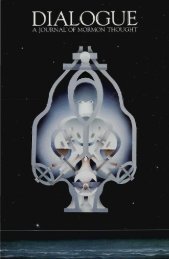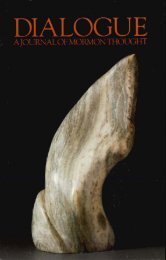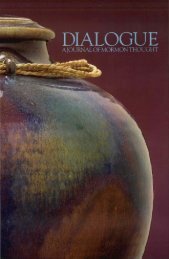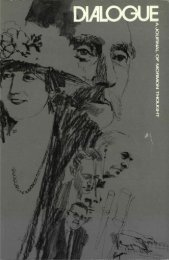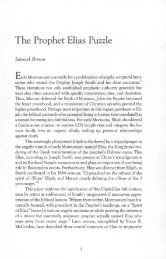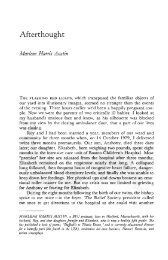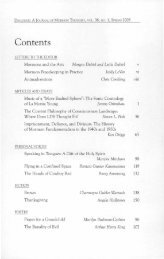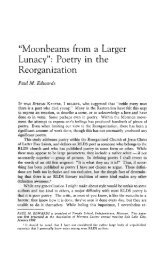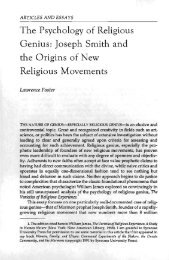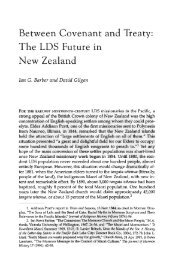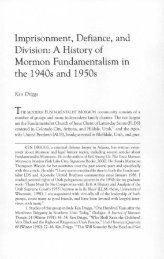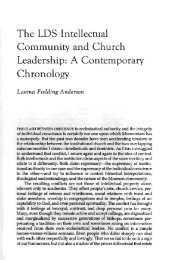Dialogue, Volume 25, Number 2 - Dialogue – A Journal of Mormon ...
Dialogue, Volume 25, Number 2 - Dialogue – A Journal of Mormon ...
Dialogue, Volume 25, Number 2 - Dialogue – A Journal of Mormon ...
You also want an ePaper? Increase the reach of your titles
YUMPU automatically turns print PDFs into web optimized ePapers that Google loves.
126 DIALOGUE: A JOURNAL OF MORMON THOUGHT<br />
the bitter and the sweet so we will know which to prize. When I joined<br />
the Church, conflict did not end for me; it began. I was living easy<br />
outside the Church, because I could always find a way to escape. Now,<br />
in the Church, I have chosen to face conflicts, make sober decisions,<br />
and deal with the consequences.<br />
While I'm still baffled about appropriate kinds <strong>of</strong> musical styles<br />
for LDS expression, I have learned a lot about the literature <strong>of</strong> the<br />
Latter-day Saints. In my literature classes at BYU, I've read volumes<br />
depicting the LDS experience in honest, inspiring, faithful, and sometimes<br />
even painful ways. For me, literature is the best place to begin to<br />
study and learn about art and life and Christianity. I now know that<br />
many good things are happening in LDS art, more than what can be<br />
found at Deseret Book or in the Ensign.<br />
Distinguishing between art produced or commissioned by the<br />
Church and art produced by individual members is also necessary.<br />
When commissioning art, the Church's goal is to convert and<br />
strengthen, so Church-commissioned art is bound to be didactic.<br />
Expecting the Ensign to be an artistic magazine is wrong. Expecting<br />
the General Authorities to write fine literature is wrong. As individual<br />
members work on their own to discover the Spirit, they may<br />
make mistakes with their art (being either too didactic or too risque);<br />
but with effort and patience, these mistakes will work themselves<br />
out.<br />
I have not completely worked out my feelings about art and the<br />
Church. What line separates a truthful depiction <strong>of</strong> evil from a glorification<br />
<strong>of</strong> it? Where do sexuality, nudity, or pr<strong>of</strong>anity fit in art, if at<br />
all? Perhaps these questions have no absolute answers. Perhaps the<br />
Spirit dictates differently in each individual situation.<br />
Even though I question, I still have a testimony <strong>of</strong> the gospel vision<br />
<strong>of</strong> the arts. I believe in Orson F. Whitney's words, "We shall yet have<br />
Miltons and Shakespeares <strong>of</strong> our own" (in Cracr<strong>of</strong>t and Lambert 1979,<br />
32). The gospel <strong>of</strong> Jesus Christ is rich enough to enable those who<br />
have received it to reveal further light and knowledge in the form <strong>of</strong><br />
literature, music, and other arts that can bring truth, beauty, and<br />
understanding to the lives <strong>of</strong> all people. Good art always does something<br />
to help us understand life, and I think that those who know God<br />
can understand life better.<br />
Whether I will become the artist that I hope to be, or just provide<br />
encouragement from the sidelines, I know that President Kimball's<br />
words will be fulfilled: great works <strong>of</strong> art will come from the Latterday<br />
Saints someday. I believe that "praiseworthy" art will be produced<br />
in our future —art that praises God, enlightens humankind, and wins<br />
the praise <strong>of</strong> people outside and inside the Church.



